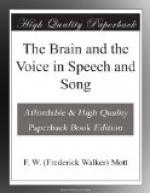PATHOLOGICAL DEGENERATIVE CHANGES PRODUCING SPEECH DEFECTS AND WHAT THEY TEACH
As I have before remarked, children utter vowel sounds before consonants, and I used this as an argument that phonation preceded articulation; but there is another reason for supposing that articulate sounds are of later development phylogenetically, as well as ontogenetically. Not only are they more dependent for their proper production on intelligence, but in those disorders of speech which occur as a result of degenerative processes of the central nervous system the difficulty of articulate speech precedes that of phonation. Take, for example, bulbar paralysis, a form of progressive muscular atrophy, a disease due to a progressive decay and destruction of the motor nerve cells presiding over the movements of the tongue, lips, and larynx, hence often called glosso-labial-laryngeal palsy. In this disease the lips, tongue, throat, and often the larynx are paralysed on both sides. “The symptoms are, so to speak, grouped about the tongue as a centre, and it is in this organ that the earliest symptoms are usually manifested.” (Gowers). Imperfect articulation of those sounds in which the tongue is chiefly concerned, viz. the lingual consonants l, r, n, and t, causing indistinctness of speech, is the first symptom; the lips then become affected and there is difficulty in the pronunciation of sounds in which the lips are concerned, viz. u, o, p, b, and m. Eventually articulate speech becomes impossible, and the only expression remaining to the patient is laryngeal phonation, slightly modulated and broken into the rhythm of formless syllables.
The laryngeal palsy rarely becomes complete. The nervous structures in the physiological mechanism of speech and phonation are affected in this disease; but there are degenerative diseases of the brain in which the psychical mechanism of speech is affected, e.g. General Paralysis of the Insane, in which the affection of speech and hand-writing is quite characteristic. There is at first a hesitancy which may only be perceptible to practised ears, but in which there is no real fault of articulation once it is started; sometimes preparatory to and during the utterance there is a tremulous motion about the muscles of the mouth. The hesitation increases,




